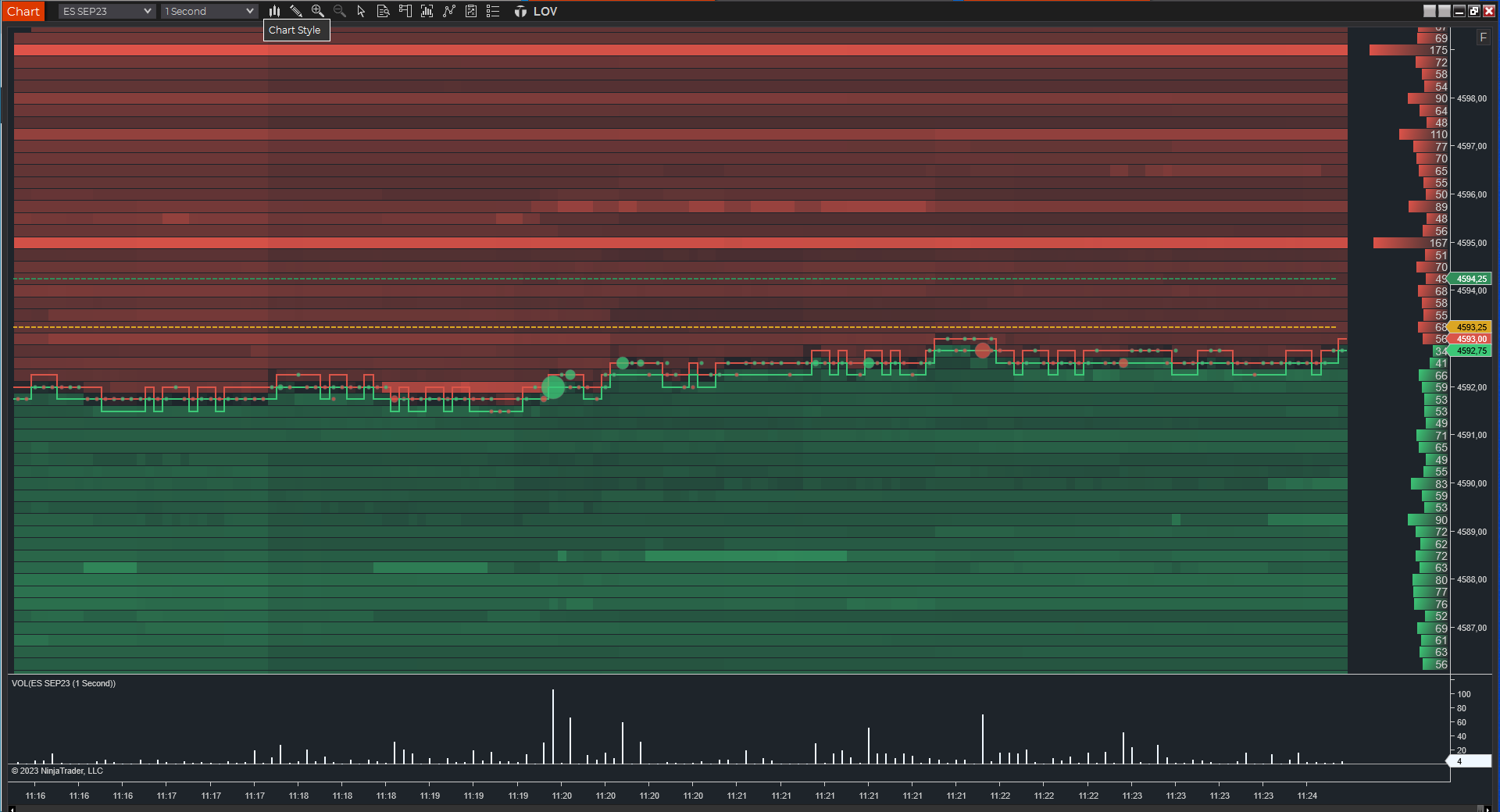Key Takeaways
- Order flow trading involves analyzing the orders entering the market to gain insights into supply and demand.
- Tools like the order book, market depth, and volume profiling are used to conduct order flow analysis.
- Trading platforms like NinjaTrader provide key features for implementing order flow trading strategies.
- Order flow analysis can be combined with technical, sentiment, and fundamental analysis for greater precision.
- Being aware of deceptive practices like spoofing prevents traders from being misled by false signals.
- Ongoing practice, learning, and risk management are crucial for trading success using orderflow strategies.
Introduction to OrderFlow trading
Order flow trading is a powerful strategy seasoned traders favor in financial markets. This involves an in-depth analysis of trade activities to foresee future price movements.
This approach provides a detailed view of market dynamics by looking at executed and pending orders and identifying potential trends, reversals, support, and resistance levels.
From understanding market liquidity and market depth to developing discretionary strategies based on this data, order flow can greatly enhance your trading success.
By studying various tools and indicators such as Level II Quotes, time and sales indicators, liquidity charts, and volume profiles, traders can accurately enter the market, predict price direction, identify support and resistance levels, and analyze buyer and seller activity.
This article explores order flow trading, focusing on its basics, tools, strategies, key concepts such as market imbalance, spoof orders, support/resistance levels, and platform selection and tips for success.
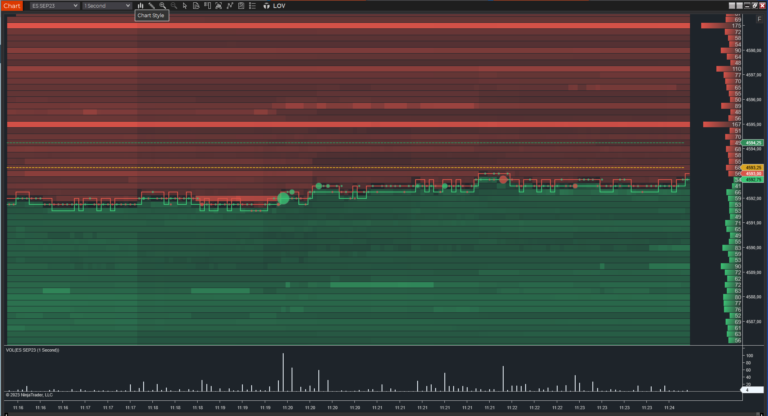
The Basics of Trading Dynamics with OrderFlow
Understanding order flow or orderflow, as it’s often referred to, is crucial for any trader looking to gain a competitive edge.
It offers a real-time market view, revealing the depth of buy and sell orders waiting to be executed at specific price levels.
Let’s examine the basics of trading dynamics and how decoding order flow gives traders an edge:
- Order flow comprises all bids and offers placed by various market participants. Traders can identify potential trends by studying the volume, direction, and speed of these orders.
- The crux of order flow trading is predicting future price moves based on current pending and executed buy/sell activities. This helps traders see where prices may be pushed up or down.
- Monitoring the order book enables traders to detect imbalances between buyers and sellers – a precursor to potential price swings.
Order flow trading utilizes various tools and indicators to analyze the flow of orders, including:
- Depth of Market (DOM) or Level II: Shows market depth and liquidity at different price levels.
- Time and Sales: Provides information on executed trades.
- Volume profiles: Graphical representation of volume traded at each price level.
- Delta: Compares buying and selling pressure.
The aim is to understand the intentions of other market participants and expect potential price movements. Order flow analysis examines advertised orders (bids and offers) and executed orders (actual transactions).
Understanding Order Flow Data in Day Trading
Order flow data provides a detailed look at the market buying and selling activity. It captures information on the price, volume, timing, and direction of orders.
Understanding and utilizing order flow data is crucial for gaining a true edge in trading, as it reveals the intentions and actions of other market participants. Here are some key aspects of order flow data:
- It shows the orders queued on the order book at different price levels. This helps traders gauge potential support and resistance zones.
- Traders can identify imbalances between buying and selling pressure by analyzing the relative aggression and intensity of orders at each price point.
- The sequential time stamps on executed trades provide insights into the speed of directional moves.
- Large block orders on the Tape provide information on potential sharp price swings.
Order flow analysis enables traders to see beyond the price action and recognize the forces driving prices. Some benefits include:
- Enhanced market insight: Provides a transparent view of market activity and depth.
- Improved trade execution: Helps traders secure optimal entries and exits.
- Risk management: Identifies potential reversals early.
Using OrderFlow data offers several key benefits that can significantly enhance your trading performance.
Enhanced Market Insight: OrderFlow data lets you see beyond the surface-level price and volume information. It provides a granular view of market activity, revealing hidden patterns and trends that may not be apparent from traditional market data. This enhanced market insight gives you a competitive edge, enabling you to make more accurate predictions and capitalize on profitable opportunities.
Improved Trade Execution: By tracking OrderFlow data, you can gauge the depth of the market and identify liquidity levels at different price points. This information helps you execute trades more efficiently, ensuring you get the best possible price and minimize slippage. Whether you are a scalper aiming for quick profits or a swing trader seeking optimal entry and exit points, OrderFlow data can significantly improve your trade execution.
Better Risk Management: OrderFlow data provides valuable information about the order flow imbalance, which can be an early indication of potential market reversals. By monitoring these imbalances, you can adjust your positions or even take contrarian trades to manage your risk effectively. OrderFlow data allows you to see the impact of large orders in real time, helping you avoid getting caught on the wrong side of a market-moving transaction. It also provides tighter stops.
Key Trading Tools
Order flow traders use various tools and indicators to conduct a comprehensive analysis of buying and selling activity in the market:
Depth Of Market
Depth of Market, Level 2, or Market Depth data provides traders with valuable information about pending orders and potential liquidity levels. It provides insights into:
- Market liquidity and transparency: The market depth exposes the total number of buyers and sellers, enhancing the understanding of current demand and supply.
- Potential support and resistance zones: It helps identify potential support or resistance levels based on volume accumulation at specific prices.
- Likelihood of order execution at certain levels: By observing pending order sizes, traders can expect future movements, especially if an unusually large order is an order likely to influence price direction significantly.
Market Depth has significantly advanced order flow trading by providing traders with detailed information about the bids and asks at different price levels in a particular market. This type of data allows traders to gain insights.
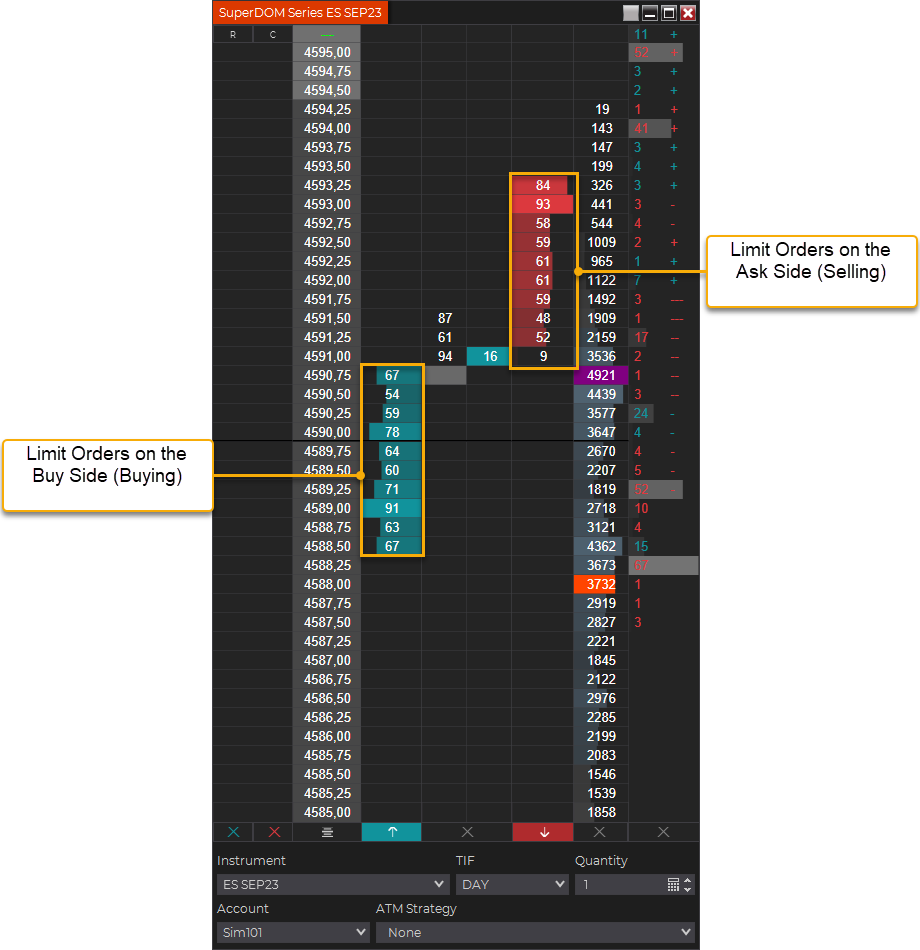
Market Depth or Level II data provides valuable insights into order flow dynamics within a particular market, allowing traders to understand supply and demand imbalances better and make more informed trading decisions.
Time and Sales
Time and Sales, also known as Tape, gives real-time insights into executed transactions and their impact on market price. It enables traders to identify:
- Periods of high selling or buying pressure
- The impact of large trades on price
- Momentum shifts
Time and Sales provides a real-time record of executed trades, including the price, volume, and time each trade occurred. By analyzing this data, traders can gain insights into the behavior of buyers and sellers in the market.
This information allows them to expect future price movements based on the dominance of one side over the other. Specifically, traders can identify whether there are more aggressive buyers than sellers or vice versa.
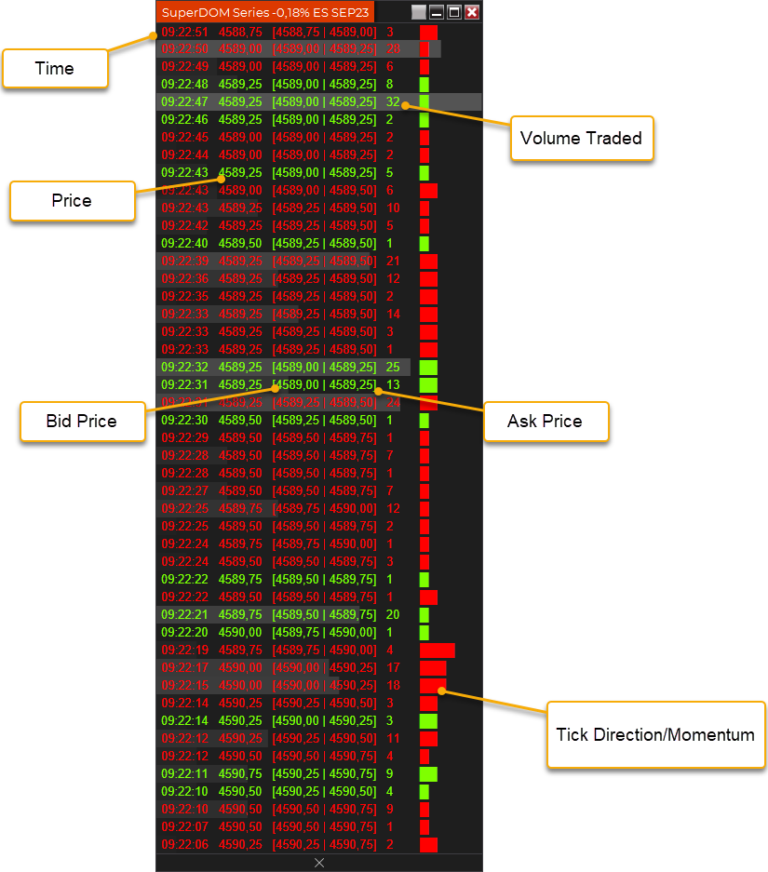
Tape Reading provides traders with a real-time stream of executed transactions, revealing nuanced details about trading activity.
This method of order flow analysis offers an in-depth view of market microstructure, capturing every tick transaction along with its volume and direction – whether it hits the buy limit orders or sell limit orders. This knowledge is invaluable in order flow trading as it helps traders make informed decisions about their positions and timing their trades effectively.
Volume Profile
Volume Profile offers a detailed view of trading volumes at different price levels over a specified period. It helps highlight the following:
- Points of control (the most traded price)
- High volume nodes
- Low volume nodes
Volume Profile is a critical tool in the arsenal of order flow trading, providing a graphical representation of trading activity over a specified period, highlighting areas where trading volume is concentrated.
This powerful indicator allows traders to identify high-volume nodes (HVN) and low-volume nodes (LVN), which often act as significant support and resistance levels.
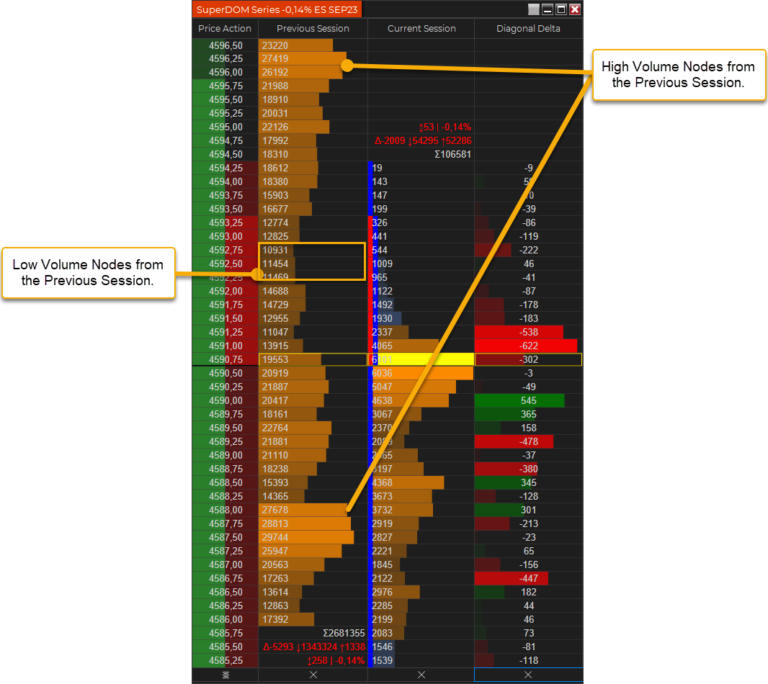
Volume Profile is a graphical representation of the volume traded at each price level over a specified period, resembling a histogram that provides traders with insights into the distribution of volume and areas of high activity within the market.
It is an essential tool in trading order flow and volume analysis as it helps traders understand the dynamics and structure of price movement. By plotting volume against price levels, traders can identify key support and resistance levels, areas of accumulation or distribution, and potential market turning points.
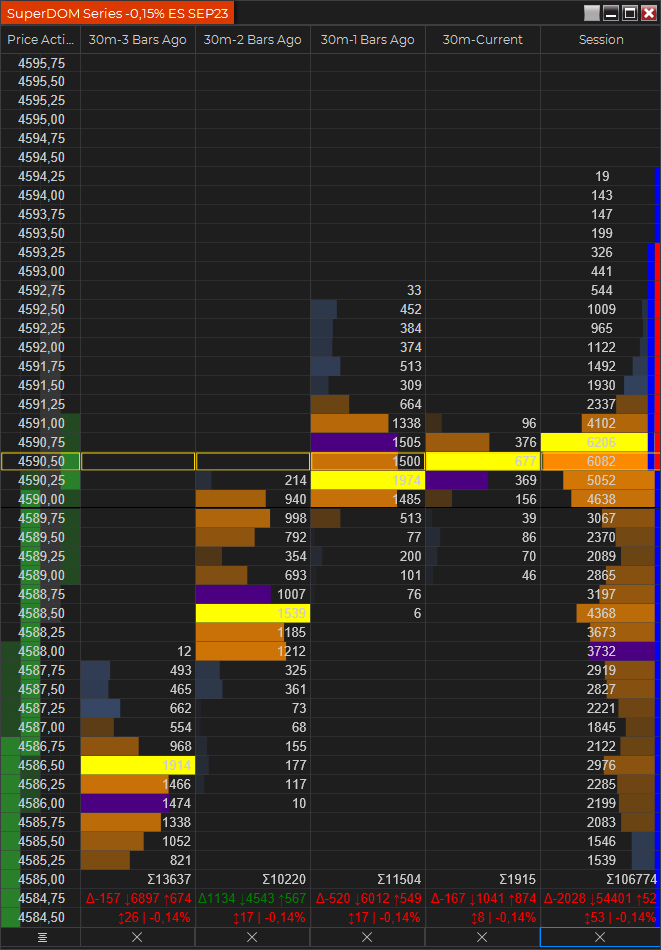
When coupled with Price Action Analysis – the study of historical price movements to predict future trends – it aids in understanding market sentiment and identifying potential trading opportunities. Analyzing this data allows traders to determine where significant buying or selling pressure exists and helps guide their trading decisions accordingly.
Overall, the Volume Profile provides valuable insights into price and volume relationships in order flow trading strategies.
Using Orderflow trading to determine levels
Analyzing the flow of trading orders through order flow trading can help traders identify potential support and resistance levels based on imbalances between buyers and sellers. By studying the order book and footprint charts, traders can see the volume of buy and sell orders at specific price points. Buy imbalances point out potential support levels, while sell imbalances point out potential resistance points. This information helps traders determine key levels where price may react or reverse.
|
Potential Support Levels |
Potential Resistance Levels |
|
Buy Imbalances |
Sell Imbalances |
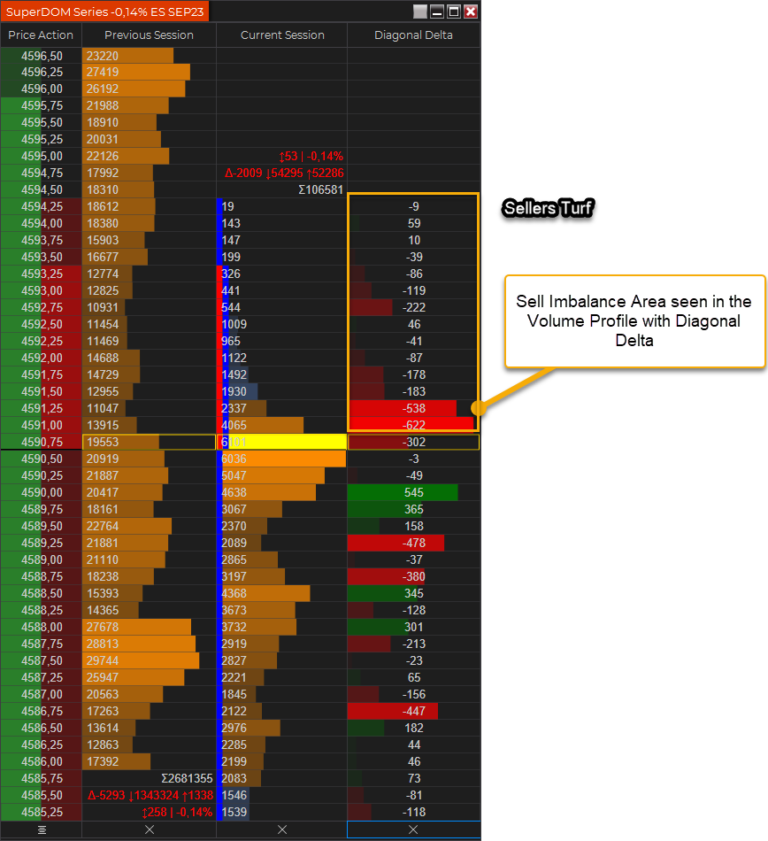
Combining with Other Strategies
Order flow trading can be complemented by incorporating insights from other analysis methodologies. This enhances traders’ understanding of market dynamics.
Technical Analysis
- Combine order flow with chart patterns, indicators like moving averages, and trendlines to identify high-probability setups better.
- Order flow adds context and confirms whether indicator signals are supported by actual buying/selling activity.
Sentiment Analysis
- Gauge overall investor psychology using sentiment indicators. Compare this with order flow data.
- If order flow shows heavy buying, but the sentiment is bearish, it could signal a contrarian opportunity.
Fundamental Analysis
- Understand how economic events and news impact order flow. This indicates whether the sentiment is short-term or an enduring trend.
- Macroevents like interest rate changes affect buyer/seller urgency – order flow analysis quantifies this impact.
Session Analysis
- Compare order flow across different trading sessions to identify times when specific types of market participants are most active.
- This helps traders focus on sessions with order flow aligned with their strategy.
|
Strategy |
How Order Flow Helps |
|
Technical Analysis |
Confirms indicator signals |
|
Sentiment Analysis |
Identifies contrarian opportunities |
|
Fundamental Analysis |
Quantifies market response to events |
|
Session Analysis |
Compares activity across sessions |
An integrated approach leveraging order flow and other strategic analyses creates a robust trading framework.
Combining order flow trading with other strategies
Combining order flow trading with other strategies can enhance traders’ ability to predict future price movements and identify potential trend reversals accurately.
This integration allows traders to leverage the insights gained from order flow analysis with the strengths of other trading strategies.
By incorporating technical, sentiment, or fundamental analysis alongside order flow trading, traders can gain a more comprehensive understanding of market dynamics and make more informed trading decisions.
This combination provides a holistic approach to trading that increases the probability of success.
Deceptive Practices (Spoofing)
While order flow analysis provides a valuable window into market activity, traders should be aware of potential deceptive tactics that distort the authenticity of the data.
Spoofing involves placing large buy or sell orders to manipulate other market participants without executing the trades. Spoofers trick other traders into responding by creating an illusion of demand or supply.
Here are some common spoofing tactics:
- Placing large orders at key support/resistance levels to give the impression of significant buying or selling interest.
- Rapidly modifying or canceling these large orders once others are fooled into reacting.
- Repeating these fake orders around important news events to increase their market-moving impact.
Impact of Spoofing
- Creates illusory support and resistance levels that mislead analysis.
- Generates false breakouts and breakdowns when spoof orders are canceled.
- Increases market volatility through amplification of the initial fake signals.
Avoiding Spoofing
- Analyze volume surges for outsized anomalies.
- Identify orders rapidly modified or canceled.
- Use tools like heat maps and market profiling to detect unusual activity.
- Wait for confirmation from additional signals before acting.
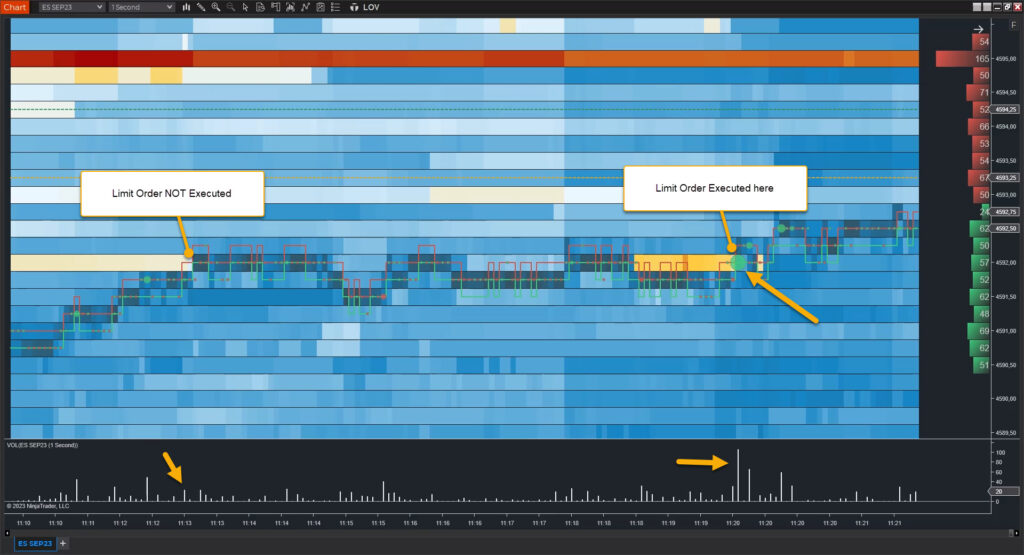
By understanding the mechanics of spoofing, traders can take protective measures to avoid being misled by deceptive order flow data. Maintaining an analytical, high-conviction approach is key.
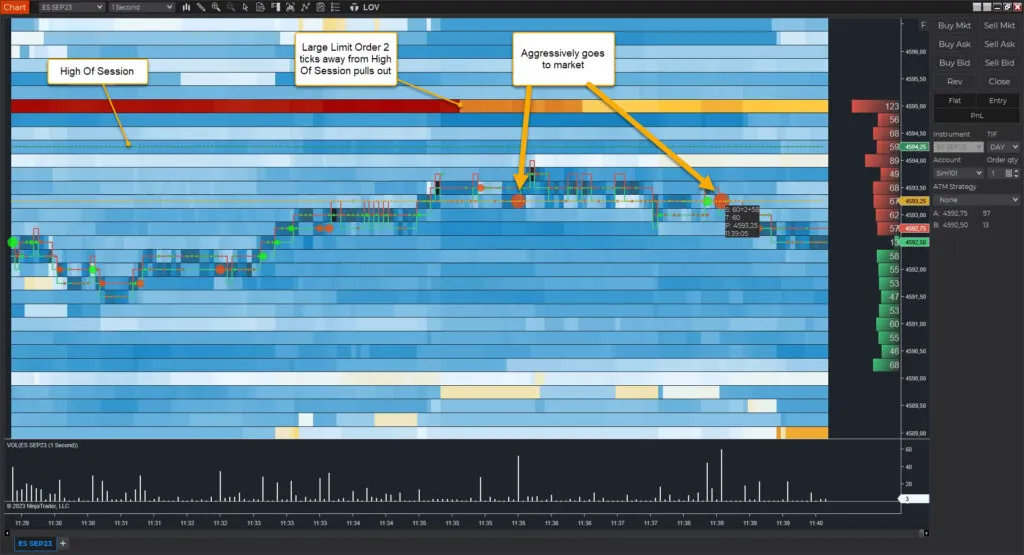
Trading Platform and Tools
Tools and platforms for order flow trading
This discussion will focus on the key points regarding the NinjaTrader platform and its SuperDOM Series.
NinjaTrader is a widely used trading software offering advanced order flow analysis features.
The SuperDOM Series within NinjaTrader provides traders with a comprehensive view of market depth, allowing them to analyze and trade directly from the order book.
NinjaTrader
NinjaTrader is a widely used orderflow charting software that offers automation capabilities for traders. It provides a range of features and tools for order flow trading.
Here are four key benefits of using NinjaTrader for order flow analysis:
- Automation: NinjaTrader allows traders to automate their strategies, enabling them to execute trades based on predefined rules.
- Customization: Traders can customize their charts, indicators, and strategies according to their trading preferences.
- Market Data: NinjaTrader provides access to real-time market data, including Level II quotes and time and sales information.
- Backtesting: Traders can use historical data to assess their effectiveness before implementing them in live trading.
SuperDOM Series
The SuperDOM Series is a collection of tools and features within NinjaTrader that enhance traders’ order flow analysis capabilities. This series provides traders with advanced real-time functionality to analyze and interpret order flow data. It includes customizable columns, dynamic order entry, real-time market depth, time and sales data, and more. The SuperDOM Series empowers traders to make informed decisions based on order flow information.
|
Features |
Benefits |
|
Customizable columns |
Allows traders to display relevant information for their specific trading strategies |
|
Dynamic order entry |
Enables quick and efficient order placement directly from the DOM |
|
Real-time market depth |
Provides a visual representation of the bid and ask levels in the market |
|
Time and sales data |
Shows the sequence of executed trades for a better understanding of market dynamics |
By utilizing the SuperDOM Series, traders can gain deeper insights into order flow patterns, identify key support and resistance levels, track buyer and seller aggression, and make more informed trading decisions.
Successful Trading Tips
Mastering order flow trading requires an adaptive approach and a commitment to continuous improvement. Here are some tips for trading success:
- Understand the context – Don’t just look at the data; comprehend why orders are placed and canceled.
- Analyze volume surges – Ask yourself what prompted the increased activity and whether it is likely to persist.
- Identify participants – Understand if institutions or retail traders drive the activity to gauge seriousness.
- Confirm market signals – Require additional validation before acting on order flow signals in isolation.
- Define risk-reward – Use stop losses and take profit levels to limit the downside.
- Review your performance – Maintain a trading journal and analyze your successes and failures.
- Update your skills – Learn new techniques and strategies to adapt to changing markets.
Tips for Success
- Develop a consistently profitable strategy that fits you!
- Enhance order flow skills through practice – Screen Time is fundamental.
- Embrace a growth mindset – Self-sabotage can be a serious issue.
- Remain flexible and open-minded. A day at a time.
|
Do’s |
Don’ts |
|
Understand the context behind orders |
Blindly follow signals |
|
Confirm signals with other factors |
Neglect risk management |
|
Maintain trading journal |
Repeat same mistakes |
|
Continuously build your skills |
Become rigid in your approach |
You can significantly improve your trading performance with robust order flow analytics, ongoing learning, and sound risk principles.
FAQ’s
Q: What is order flow trading?
A: Order flow trading is a strategy traders use to analyze the flow of buy and sell orders in the market. It involves tracking the volume and price of these orders to gain insight into market sentiment and potential price movements.
Q: How do order flow trading strategies work?
A: Order flow trading strategy involves analyzing the order book, which displays all the pending buy and sell orders for a particular asset. Traders look for patterns, imbalances, and changes in the order book that may indicate potential market movements.
Q: What are some popular order flow trading indicators?
A: Some popular order flow trading indicators include Volume Profile, the Order Book, Time and Sales Data, Liquidity Heatmaps, VWAP (Volume Weighted Average Price), bid/ask volume, volume delta, and order flow tools that visualize the order book.
Q: How can I use order flow analysis in my trading?
A: You can use order flow analysis to identify potential support and resistance levels, confirm breakouts, gauge market sentiment, and make more informed trading decisions.
Q: What is a Market order?
A: A market order is an order to buy or sell an asset at the current price in the market. It gets executed at once at the current market price.
Q: What is a Limit order?
A: A limit order is buying or selling an asset at a specified price or better. Unlike a market order, a limit order only executes at the set price or a more favorable one, offering more control over the transaction price. But, it’s not guaranteed to execute if the market price doesn’t reach the limit price.
Q: What is VWAP?
A: VWAP stands for Volume Weighted Average Price. It calculates the average price weighted by trading volume over a specified period. VWAP is commonly used by traders to identify fair value and to determine if a stock is trading above or below its average price.
Q: How can I use the order flow to improve my trading?
A: By using the order flow, you can see other traders’ real-time buying and selling activities. This information can help you gauge market sentiment, identify potential entry and exit points, and make more informed trading decisions.
Q: What is the best order flow strategy for beginners?
A: As a beginner, it is recommended to start with a basic order flow strategy that involves analyzing the order book, monitoring the volume and price changes, and looking for abnormalities or imbalances in the order flow that may indicate potential trading opportunities.
Q: Can I use order flow trading in Forex?
A: While there is no reliable volume data that one can use to understand order flow in Forex, it is still possible to understand order flow with the help of previous price action activities. By tracking the volume and price movements of buy and sell orders, you can gain valuable insights into market sentiment and potential price movements in the Forex market.
Q: Is order flow trading suitable for day traders?
A: Yes, order flow trading is suitable for day traders. Day traders can use order flow analysis to identify short-term trading opportunities based on the market’s real-time buying and selling activities.
Final Words
Order flow trading involves analyzing the flow of orders in the market to predict future price movements. Traders use various tools and indicators to analyze advertised and executed orders, such as Level II Quotes, time and sales indicators, liquidity charts, volume profiles, market profiles, and delta.
In today’s complex trading environment, gaining a strategic edge requires going beyond just price action on charts. Comprehensively analyzing order flow using the right tools provides invaluable insights into evolving market dynamics.
By combining order flow trading with sound risk and money management principles, traders can significantly enhance their performance. But, as markets continuously change character, adapting to new developments through ongoing education is vital for long-term success.
It’s important to note that order flow indicators should be used with other technical and fundamental analysis tools to make informed trading decisions. Also, the effectiveness of these indicators may vary depending on the specific market conditions and trading strategy being employed.
Mastering order flow analysis takes commitment, but it empowers traders to base decisions on hard data rather than guesswork. It provides the context that transforms trading from gambling to a skills-based endeavor grounded in logic, analytics, and high-probability strategies.
